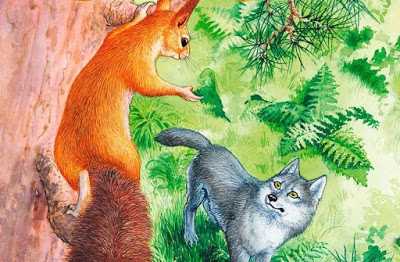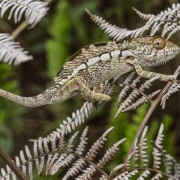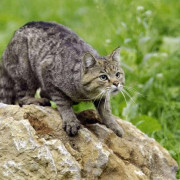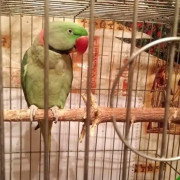Пака: характер и значение имени
Содержание:
Feeding
Foraging pacas in Costa Rica
In the wild, pacas eat fruits from understory trees and fallen fruits from taller trees, but may also eat leaves, buds, flowers, fungi, and insects. They play a vital role in seed dispersal, and, with seasonal adaptations, their home ranges are often centered on a group of fruit trees. Pacas normally do not use their fore-paws to manipulate fruits (as do agoutis), instead using their powerful jaw muscles to break open hard-shelled fruits. Unlike agoutis, pacas can store fat, and so are less dependent on the caching of seeds. Competition from agoutis is avoided by a slight variation in activity cycles and food preferences. Like rabbits, pacas are coprophagous and absorb protein and carbohydrates from specially produced moist fecal pellets. Before allowing their young to suckle, mothers lick them to stimulate them to defecate and urinate, and then lick the resulting product, both to feed herself and to prevent the odour from attracting predators.
Саундтреки
Из фильма В центре вниманияИз фильма Ван ХельсингИз сериала Дневники ВампираИз фильма Скауты против зомбииз фильмов ‘Миссия невыполнима’Из фильма Голодные игры: Сойка-пересмешница. Часть 2OST ‘Свет в океане’OST «Большой и добрый великан»из фильма ‘Новогодний корпоратив’из фильма ‘Список Шиндлера’ OST ‘Перевозчик’Из фильма Книга джунглейиз сериала ‘Метод’Из фильма ТелохранительИз сериала Изменыиз фильма Мистериум. Тьма в бутылкеиз фильма ‘Пассажиры’из фильма ТишинаИз сериала Кухня. 6 сезониз фильма ‘Расплата’ Из фильма Человек-муравейиз фильма ПриглашениеИз фильма Бегущий в лабиринте 2из фильма ‘Молот’из фильма ‘Инкарнация’Из фильма Савва. Сердце воинаИз сериала Легко ли быть молодымиз сериала ‘Ольга’Из сериала Хроники ШаннарыИз фильма Самый лучший деньИз фильма Соседи. На тропе войныМузыка из сериала «Остров»Из фильма ЙоганутыеИз фильма ПреступникИз сериала СверхестественноеИз сериала Сладкая жизньИз фильма Голограмма для короляИз фильма Первый мститель: ПротивостояниеИз фильма КостиИз фильма Любовь не по размеруOST ‘Глубоководный горизонт’Из фильма Перепискаиз фильма ‘Призрачная красота’Место встречи изменить нельзяOST «Гений»из фильма ‘Красотка’Из фильма Алиса в ЗазеркальеИз фильма 1+1 (Неприкасаемые)Из фильма До встречи с тобойиз фильма ‘Скрытые фигуры’из фильма Призывиз сериала ‘Мир Дикого Запада’из игр серии ‘Bioshock’ Музыка из аниме «Темный дворецкий»из фильма ‘Американская пастораль’Из фильма Тарзан. ЛегендаИз фильма Красавица и чудовище ‘Искусственный интеллект. Доступ неограничен»Люди в черном 3’из фильма ‘Планетариум’Из фильма ПрогулкаИз сериала ЧужестранкаИз сериала Элементарноиз сериала ‘Обратная сторона Луны’Из фильма ВаркрафтИз фильма Громче, чем бомбыиз мультфильма ‘Зверопой’Из фильма БруклинИз фильма Игра на понижениеИз фильма Зачарованнаяиз фильма РазрушениеOST «Полный расколбас»OST «Свободный штат Джонса»OST И гаснет светИз сериала СолдатыИз сериала Крыша мираИз фильма Неоновый демонИз фильма Москва никогда не спитИз фильма Джейн берет ружьеИз фильма Стражи галактикииз фильма ‘Sos, дед мороз или все сбудется’OST ‘Дом странных детей Мисс Перегрин’Из игры Contact WarsИз Фильма АмелиИз фильма Иллюзия обмана 2OST Ледниковый период 5: Столкновение неизбежноИз фильма Из тьмыИз фильма Колония Дигнидадиз фильма ‘Страна чудес’Музыка из сериала ‘Цвет черёмухи’Из фильма Образцовый самец 2из фильмов про Гарри Поттера Из фильма Дивергент, глава 3: За стеной из мультфильма ‘Монстр в Париже’из мультфильма ‘Аисты’Из фильма КоробкаИз фильма СомнияИз сериала Ходячие мертвецыИз фильма ВыборИз сериала Королек — птичка певчаяДень независимости 2: ВозрождениеИз сериала Великолепный векиз фильма ‘Полтора шпиона’из фильма Светская жизньИз сериала Острые козырьки
Behavior
Pacas inhabit rainforests, cloud forests, and sometimes more open habitats. They are great swimmers and prefer to be near water. They dive when threatened and can stay submerged up to 15 minutes. They can also jump up to 1 m (3 ft 3 in) and freeze for up to 45 minutes. They normally move along well-established paths and will create new paths when old ones are disturbed.
They are normally passive in daytime and forage in the morning and afternoon, but can be strictly nocturnal in areas with many predators. They live in burrows up to 3 m (9.8 ft) deep, normally with two entrances covered with leaves to hide the burrow and to serve as an early warning system. Burrows are often near water, but always above the seasonal flood line. Predators except humans include jaguar, puma, ocelot, margay, jaguarundi, bush dog, boa constrictor, and caiman.
Pacas have resonating chambers in their cheeks and their growling noise, at about 1 kHz, is surprisingly loud for their size. Aside from making noises, territories are marked with urine. Population density can reach up to 70 adults per 0.2 km2 (0.077 sq mi), and pacas often constitute some 20% of the biomass of terrestrial mammals.
Reproduction
Gestation lasts between 114 and 119 days with about 190 days between births. Pacas are precocial, the young are born with fur and open eyes. Normally, mothers give birth to one young, but she can give birth up to three times per year if conditions allow. More than one birth per year results in lactation periods overlapping pregnancies. Weaning begins after six weeks, but the young start to follow their mothers early and can do so for up to a year.
Sexual maturity is reached after 6–12 months, when females weigh about 6.5 kg (14 lb) and males 7.5 kg (17 lb). Pacas usually mate in water. As the male approaches the female, she starts to hop enthusiastically, more so if he sprays her with urine. Pacas have altered the common rodent strategy — safety in numbers — and mind their offspring carefully. At 650–710 g (23–25 oz) at birth, the young are born in holes too small for both predators and the mother to enter, which are then covered with leaves and twigs. To invite the young out of the hole, the mother uses a low rolling vocalization. Suckling usually lasts for 90 days, after which the young weights 4 kg (8.8 lb).
Подборки
Армейские ПесниКлассика пианиноМузыка из рекламыДетские песни из мультфильмовМузыка для аэробикиСборник песен 70х годовДля любимого человекаКлассика в современной обработкеКлубные миксы русских исполнителей3D ЗвукДальнобойщикиЗарубежный рэп для машиныТоповые Клубные ТрекиМощные БасыДискотека 2000Песни про папуХристианские ПесниЗимняя МузыкаМузыка Для МедитацииРусские Хиты 90ХГрустная МузыкаRomantic SaxophoneТанцевальный хип-хопНовогодние песниЗарубежные хиты 80 — 90Песни про покемонаРомантическая МузыкаМотивация для тренировокМузыка для сексаМузыка в машинуДля силовых тренировокПремия «Grammy 2017»
Description
Paca
Pacas are 50–77 cm (20–30 in) in length, excluding the 13–23 cm (5.1–9.1 in) short tail, weigh 6–14 kg (13–31 lb), and are the sixth-largest rodents in the world. Similar to guinea pigs, they have square heads, small ears, sides patterned with spots and stripes, and virtually invisible tails.
With large hind limbs, small fore limbs, and cone-shaped bodies, pacas are similar in appearance to the deer-like, ungulate chevrotains, and like them have four to seven horizontal lines of blotches and stripes along their flanks. They have a heavy and robust appearance, though their legs are long and relatively tiny. Their small ears are set high on their heads. They have four toes on their fore feet and five on their hind feet (of which two are short and hardly touch the ground) and they have stout nails that resemble small hooves. In young pacas, the skin is covered with horny scales about 2 mm (0.079 in) in diameter; perhaps these scales have a protective function against smaller predators. There is virtually no difference between sexes. They can live up to 13 years in the wild.
Hungarian[edit]
paca (plural pacák)
- () inkspot
Declensionedit
| Inflection (stem in long/high vowel, back harmony) | ||
|---|---|---|
| singular | plural | |
| nominative | ||
| accusative | ||
| dative | ||
| instrumental | ||
| causal-final | ||
| translative | ||
| terminative | ||
| essive-formal | ||
| essive-modal | — | — |
| inessive | ||
| superessive | ||
| adessive | ||
| illative | ||
| sublative | ||
| allative | ||
| elative | ||
| delative | ||
| ablative | ||
| non-attributivepossessive — singular | ||
| non-attributivepossessive — plural |
| Possessive forms of paca | ||
|---|---|---|
| possessor | single possession | multiple possessions |
| 1st person sing. | pacám | pacáim |
| 2nd person sing. | pacád | pacáid |
| 3rd person sing. | pacája | pacái |
| 1st person plural | pacánk | pacáink |
| 2nd person plural | pacátok | pacáitok |
| 3rd person plural | pacájuk | pacáik |
English[edit]
Cuniculus paca
Nounedit
paca (plural )
- Any of the large rodents of the genus Cuniculus (but see also ), native to Central America and South America, which have dark brown or black fur, a white or yellowish underbelly and rows of white spots along the sides.
Translationsedit
rodent of genus Cuniculus
|
|
AACP, ACPA, APAC, CAAP, CAPA, capa












